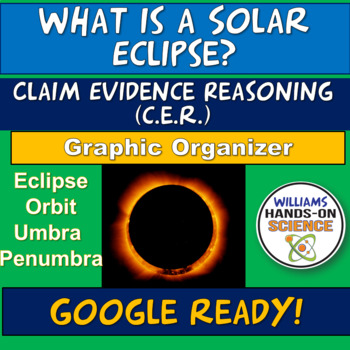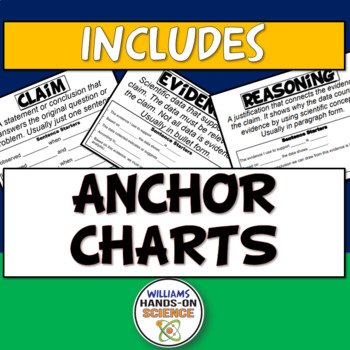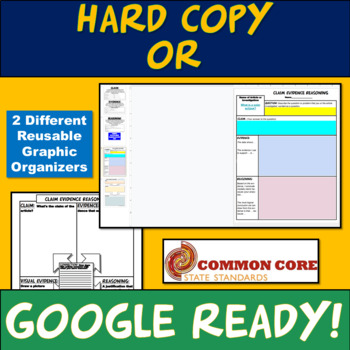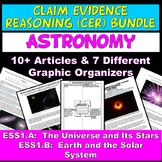MS-ESS1-2 HS-ESS1-4 Solar System Eclipse Claim Evidence Reasoning Digital
- Zip
- Google Apps™

Also included in
- Students learn about various current events and discoveries in Astronomy through a C.E.R. (Claim Evidence Reasoning) graphic organizer. This is great for getting your students to explain phenomena in a meaningful way and it allows you as the instructor to adequately assess their understanding of conPrice $34.00Original Price $66.50Save $32.50
Description
Students learn how different types of solar eclipses occur through a C.E.R. (Claim Evidence Reasoning) graphic organizer. This is great for getting your students to explain phenomena in a meaningful way and it allows you as the instructor to adequately assess their understanding of concepts. The students figure out what the "Claim" is in the article, they then use data that supports the claim in the "Evidence" section, draw visual evidence and then explain why the evidence supports the claim in the "Reasoning" section.
This is great for a current event, sub plan, homework, critical thinking, scaffolding and/or reinforcement of concepts!
You get a CER graphic organizer, an editable key, the article, tips for CER and the link to the website in the article.
The article has the following concepts:
Solar Eclipse
Orbit
Earth, Moon and Sun Alignment
Total, Annular, Partial and Hybrid
Elliptical
Umbra
Penumbra
Sunspots
Save money and Take a look at my CER Mega bundle!
Save money and Take a look at my NGSS Integrated Astronomy Waves & Magnetism Resource Bundle
What you get with this resource:
-2 graphic organizer PDF's
-2 Google Ready graphic organizers
-Anchor chart to scaffold and support students with CER
-Article Link in Google Slideshow
-Google Classroom Tutorial
Related Products:
NGSS ESS1.A ESS1.B Claim Evidence Reasoning Astronomy Bundle Graphic Organizers
Seasons PowerPoint Earth, Moon and Sun Tides Guided Notes
Moon Phases Oreo Lab NGSS MS-ESS1-1: Google Ready Modeling
Gravity & Solar System NGSS ESS1.A ESS1.B Online Simulation Google Ready
Solar System Planets Flier Jigsaw Activity Gallery Walk NGSS
Distance Learning NGSS MS-ESS1-1 Seasons Stop Motion Movie Modelling Google
NGSS for Middle School:
ESS1.B: Earth and the Solar System
•The solar system consists of the sun and a collection of objects, including planets, their moons, and asteroids that are held in orbit around the sun by its gravitational pull on them.(MS-ESS1-2), (MS-ESS1-3)
•This model of the solar system can explain eclipses of the sun and the moon. Earth’s spin axis is fixed in direction over the short-term but tilted relative to its orbit around the sun. The seasons are a result of that tilt and are caused by the differential intensity of sunlight on different areas of Earth across the year.
(MS-ESS1-1)
NGSS for High School:
ESS1.B: Earth and the Solar System
•Kepler’s laws describe common features of the motions of orbiting objects, including their elliptical paths around the sun. Orbits may change due to the gravitational effects from, or collisions with, other objects in the solar system. (HS-ESS1-4)
Engaging in Argument from Evidence:
In 9–12 builds on K–8 experiences and progresses to using appropriate and sufficient evidence and scientific reasoning to defend and critique claims and explanations about the natural and designed world(s). Arguments may also come from current scientific or historical episodes in science.
CCC's: Patterns
Observed patterns of forms and events guide organization and classification, and they prompt questions about relationships and the factors that influence them.
TERMS OF USE
• All rights reserved by Williams Hands On Science, Inc.
• This product is to be used by the original purchaser only.
• Intended for classroom and personal use only.
• Copying for more than one teacher, classroom, department, school, or school system is prohibited.
• This product may not be distributed or displayed digitally for public view.
• Failure to comply is a copyright infringement and a violation of the Digital Millennium Copyright Act (DMCA).
If there are any errors or questions, please contact me through TpT or email me at:
williamshandsonscience@gmail.com
Thank you for taking a look!
Please follow me on TpT for new products and check me out on Instagram for my products in action!






